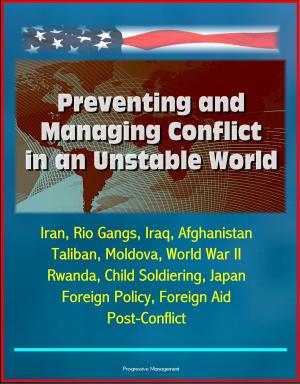Al-Qaida After Ten Years of War: A Global Perspective of Successes, Failures, and Prospects - Iraq and Afghanistan, Pakistan, Arab Spring, Tuaregs, bin Laden, Egypt, al-Shabaab, al-Qaeda
Nonfiction, History, Military, Social & Cultural Studies, Political Science| Author: | Progressive Management | ISBN: | 9781310757501 |
| Publisher: | Progressive Management | Publication: | May 21, 2014 |
| Imprint: | Smashwords Edition | Language: | English |
| Author: | Progressive Management |
| ISBN: | 9781310757501 |
| Publisher: | Progressive Management |
| Publication: | May 21, 2014 |
| Imprint: | Smashwords Edition |
| Language: | English |
Since the September 2001 attacks on the world Trade Center and the Pentagon, the United States has been at war with Al-Qaida. Over the past 10 years, counterterrorism efforts have disrupted its main training facilities and eliminated much of the core leadership structure, including the mastermind Usama Bin Ladin. Despite this, Al-Qaida has proved resilient. while the core leadership has been compromised, regional Al-Qaida offshoots and affiliated Islamist terrorist groups have formed, developed, and become prominent in their own right. To aid in examining and explaining Al-Qaida's trajectory, the Minerva Initiative at Marine Corps University hosted a conference in the spring of 2011, just days before Bin Ladin's demise. The panels at this conference addressed diverse issues such as Al-Qaida's overarching strategy; the degree of control that central Al-Qaida leadership maintains over regional franchises; and the strategies, tactics, successes, and failures in each theater of operation. The resulting papers in Al-Qaida after Ten Years of War contribute to the ongoing and ever-evolving net assessment of Al-Qaida and its future prospects, and they help inform the crafting of a war termination phase with Al-Qaida.
Al-Qaida After Ten Years of War - A Global Perspective of Successes, Failures, and Prospects * 1. Keynote Address: The Deep Fight * 2. Al-Qaida's War with the United Nations and the State System * 3. Al-Qaida's Theater Strategy: Waging a World War * 4. East Africa and the Horn * 5. The State of Al-Qaida in Southeast Asia Ten Years since 9/11 * 6. Al-Qaida and Terrorism in the Arab East: Rise, Decline, and the Effects of Doctrine Revisions and the Arab Revolutions * 7. Al-Qaida in the Islamic Maghreb * 8. Al-Qaida and Central Asia: A Slowly Developing and Multipurpose Presence * 9. Power by Proxy: Al-Qaida in Pakistan * 10. Toward a Differential Analysis of Al-Qaida and the Jihadist Terrorist Threat to Western European Nations * 11. Al-Qaida and the United States: A Panel Presentation
Topics and subjects covered include: Bin Laden, Tuaregs, Egypt, Pakistan, Iraq, Afghanistan, Iran, Libya, Somalia, Sudan, Al-Shabaab, Afghanistan, Arab Spring, Algeria, Sahel
Since the September 2001 attacks on the world Trade Center and the Pentagon, the United States has been at war with Al-Qaida. Over the past 10 years, counterterrorism efforts have disrupted its main training facilities and eliminated much of the core leadership structure, including the mastermind Usama Bin Ladin. Despite this, Al-Qaida has proved resilient. while the core leadership has been compromised, regional Al-Qaida offshoots and affiliated Islamist terrorist groups have formed, developed, and become prominent in their own right. To aid in examining and explaining Al-Qaida's trajectory, the Minerva Initiative at Marine Corps University hosted a conference in the spring of 2011, just days before Bin Ladin's demise. The panels at this conference addressed diverse issues such as Al-Qaida's overarching strategy; the degree of control that central Al-Qaida leadership maintains over regional franchises; and the strategies, tactics, successes, and failures in each theater of operation. The resulting papers in Al-Qaida after Ten Years of War contribute to the ongoing and ever-evolving net assessment of Al-Qaida and its future prospects, and they help inform the crafting of a war termination phase with Al-Qaida.
Al-Qaida After Ten Years of War - A Global Perspective of Successes, Failures, and Prospects * 1. Keynote Address: The Deep Fight * 2. Al-Qaida's War with the United Nations and the State System * 3. Al-Qaida's Theater Strategy: Waging a World War * 4. East Africa and the Horn * 5. The State of Al-Qaida in Southeast Asia Ten Years since 9/11 * 6. Al-Qaida and Terrorism in the Arab East: Rise, Decline, and the Effects of Doctrine Revisions and the Arab Revolutions * 7. Al-Qaida in the Islamic Maghreb * 8. Al-Qaida and Central Asia: A Slowly Developing and Multipurpose Presence * 9. Power by Proxy: Al-Qaida in Pakistan * 10. Toward a Differential Analysis of Al-Qaida and the Jihadist Terrorist Threat to Western European Nations * 11. Al-Qaida and the United States: A Panel Presentation
Topics and subjects covered include: Bin Laden, Tuaregs, Egypt, Pakistan, Iraq, Afghanistan, Iran, Libya, Somalia, Sudan, Al-Shabaab, Afghanistan, Arab Spring, Algeria, Sahel















